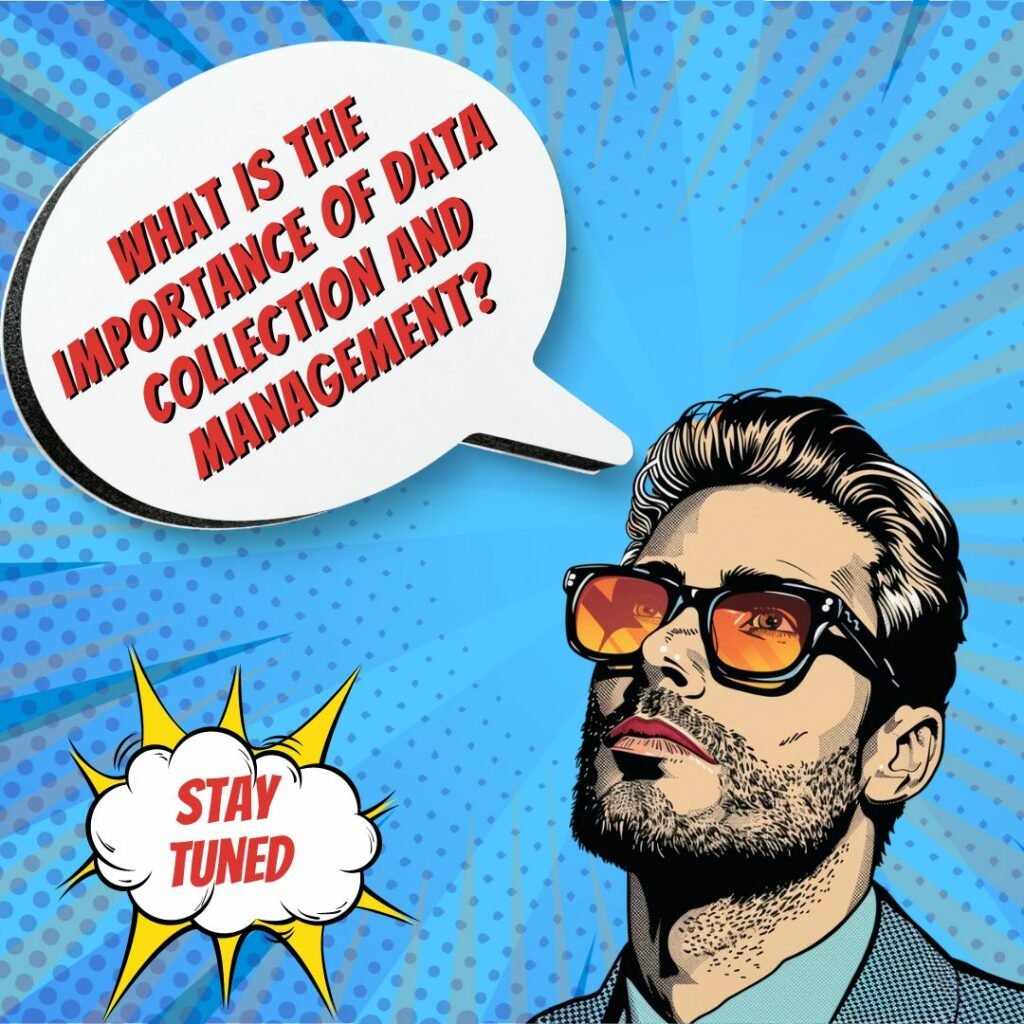Key Takeaways
✅ Accuracy and Quality: Precision in data collection is non-negotiable. Employ stringent methods and reliable sources, and maintain the standard of data to ensure your decisions rest on solid ground.
✅ Organization and Storage: Your data’s home matters. Opt for top-tier storage solutions, maintain a clear structure, and follow best practices in data management to ensure your insights are always within reach.
✅ Security and Privacy: Handle data with the utmost care. Implement cutting-edge security protocols, respect privacy laws, and uphold ethical standards to fortify trust and integrity within your data environment.

Introduction
Attention data enthusiasts and e-commerce trailblazers – have you ever considered the impact of robust data collection and management on your business’s backbone? Picture this: a world where data isn’t just numbers but a narrative that guides your every strategic move. Within this article lies the blueprint to evolve from a simple data gatherer to a master of insightful and strategic data utilization. E-commerce operations are increasingly driven by data intelligence, making this guide indispensable for staying ahead in the digital race.
Expect pioneering insights in our exploration, leading you through cutting-edge trends and modern solutions that can supercharge your revenue, optimize ROAS, and skyrocket ROI. This is more than a conversation about raw data; it’s about transforming that data into actionable strategies for undeniable market advantage.
Tantalize your intellect and prepare to uncover groundbreaking techniques that promise to redefine the reach of your business’s data capabilities. Stay tuned for an empowering journey into the essence of data collection and management—a journey that culminates in actionable insights for not just surviving but flourishing in the competitive arena of e-commerce.
Top Statistics
| Statistic | Insight |
|---|---|
| Global Big Data Analytics Market Growth: Expected to reach $68.1 billion by 2025, growing at a CAGR of 18.1%. (Source: MarketsandMarkets) | This impressive CAGR underscores the critical demand for advanced analytics in making data-driven decisions. |
| Cloud-Based Data Collection Market Expansion: Forecasted to grow from $1.4 billion in 2020 to $5.7 billion by 2025, at a CAGR of 31.1%. (Source: ReportLinker) | A surge signaling the shift towards cloud solutions, promising scalability and accessibility for businesses of all sizes. |
| Enterprise Workloads in the Cloud: 83% will be in the cloud by 2021. (Source: LogicMonitor) | This majority indicates a compelling move to the cloud, driven by the need for efficient data management and flexibility. |
| Global Data Creation Projections: Expected to grow to over 180 zettabytes by 2025. (Source: IDC) | An astonishing data proliferation calling for robust, innovative strategies in data storage, processing, and analytics. |
| Global Data Collection and Labeling Market Growth: Predicted to surge from $1.6 billion in 2020 to $8.2 billion by 2025, at a CAGR of 32.9%. (Source: Grand View Research) | Demonstrates the rapidly growing niche for quality data, crucial for training AI and machine learning algorithms. |
Understanding Data Collection
At its core, data collection is the process of gathering and storing information from various sources. It's a crucial step that lays the foundation for all the data-driven initiatives within a business. But what exactly is data, and why is it so important?
Data can come in many forms - structured, unstructured, qualitative, or quantitative. It can be gathered from internal sources like customer records and operational data, or from external sources like market research and public datasets. The methods used to collect this data can vary widely, from traditional surveys and interviews to more advanced techniques like web scraping and sensor-based monitoring.
The key to effective data collection is understanding what information you need and why. By aligning your data collection efforts with your business objectives, you can ensure that you're gathering the right data to drive meaningful insights and make strategic decisions.
Effective Data Collection Strategies
Once you've identified your data requirements, the next step is to design efficient and reliable data collection processes. This may involve automating certain tasks, standardizing data formats, and implementing rigorous quality control measures to ensure the accuracy and integrity of your data.
At the same time, it's crucial to consider the ethical and privacy implications of your data collection efforts. As data becomes an increasingly valuable asset, companies must be mindful of how they gather, store, and use sensitive information to maintain the trust of their customers and stakeholders.
Data Management Principles
Effective data management is the foundation of any successful data-driven organization. This involves establishing robust systems for storing, organizing, and securing your data assets. From databases and data warehouses to data lakes and governance policies, the way you manage your data can have a significant impact on your ability to extract valuable insights.
Data security and access control are also critical components of data management. With sensitive information at risk, companies must implement robust measures to protect their data from unauthorized access, breaches, and misuse.
Data Analysis and Decision Making
Once you've collected and organized your data, the next step is to transform it into actionable insights. By leveraging a range of data analytics techniques, from descriptive to predictive and prescriptive, businesses can uncover patterns, trends, and correlations that can inform strategic decision-making.
The key is to ensure that these data-driven insights are seamlessly integrated into your decision-making processes. This requires a cultural shift towards a more data-driven mindset, where stakeholders at all levels of the organization are empowered to make informed, evidence-based decisions.
Challenges and Best Practices
Of course, the journey to becoming a data-driven organization is not without its challenges. Data quality issues, such as incomplete, inaccurate, or inconsistent data, can undermine the reliability of your insights. Data integration and interoperability between disparate systems can also be a significant hurdle, as can the change management required to foster a data-driven culture within your organization.
To overcome these challenges, it's essential to adopt best practices in data collection and management. This may involve implementing robust data governance frameworks, investing in data quality assurance processes, and prioritizing data literacy and training for your employees.
By embracing these strategies and overcoming the common pitfalls, businesses can unlock the true power of their data and position themselves for long-term success in the increasingly competitive, data-driven landscape.
Inspirational Quotes
1.“Data is the new oil.“– Clive Humby
This iconic quote emphasizes the immense value and potential of data in today’s world. Just like oil was crucial for powering industries during the industrial revolution, data now fuels innovation, decision-making, and growth across various sectors. The challenge lies in collecting, managing, and extracting insights from this valuable resource responsibly and effectively.
2.“Getting information off the internet is like taking a drink from a fire hydrant.” – Mitchell Kapor
In an era where data collection and management have become increasingly complex due to the sheer volume of available information, this quote reminds us of the need for efficient strategies and tools to handle such vast amounts of data. Without proper organization and analysis, the abundance of data can quickly turn into overwhelming noise rather than actionable knowledge.
3. “The goal is to turn data into information, and information into insight.” – Carly Fiorina
Fiorina’s statement encapsulates the essence of effective data collection and management: transforming raw numbers and figures into meaningful intelligence that guides informed decisions. This process requires not only technical expertise but also critical thinking skills and creativity to uncover hidden patterns and trends within the data. By doing so, organizations can gain competitive advantages and drive innovations for the future.
AI Marketing Engineers Recommendation
Recommendation 1: Implement Progressive Profiling to Enrich Data Collection: Begin using progressive profiling on your lead capture forms. This technique involves gradually collecting more information about your prospects each time they engage with your brand, rather than asking for too many details up front and risking form abandonment. By analyzing the data from these interactions, you can enhance personalization and improve customer experiences. According to a Forrester report, personalized campaigns can deliver five to eight times the ROI on marketing spend. Progressive profiling is not only respectful of the customer’s journey and privacy but also builds a robust dataset over time.
Recommendation 2: Embrace Predictive Analytics for Strategic Decision-Making: Utilize predictive analytics tools to forecast future customer behavior based on your existing data. These tools can identify patterns that human analysts may miss, allowing you to anticipate trends, manage inventory more effectively, and create targeted marketing campaigns. As per a survey by Deloitte, organizations that leverage predictive analytics can witness a 73% increase in sales. The strategic deployment of predictive analytics can transform your decision-making from reactive to proactive, keeping you ahead of the competitive curve.
Recommendation 3: Leverage Consent Management Platforms (CMPs) to Build Trust: Integrate Consent Management Platforms into your data management strategy. CMPs empower users to control their data privacy preferences and provide transparent data usage policies, which is crucial as privacy regulations tighten globally. The use of CMPs not only aligns your business with GDPR, CCPA, and other privacy laws but also nurtures consumer trust. TrustArc’s Privacy Management Benchmark Report revealed that trust in data practices led to a growth in engagement, with 91% of consumers more likely to purchase from brands they trust. CMPs streamline compliance, enhance customer relations, and ensure ethical data handling.
Conclusion
As e-commerce professionals, we stand at the precipice of an era overflowing with data. The quintessence of mastering data collection and management is not just in harnessing vast amounts of information but in leveraging the right kind, and quality, of data to inform strategic decisions that propel our businesses forward. From the nuanced crafting of surveys to the meticulous mining of secondary data sources, each method carries its unique strengths and challenges.
However, beyond collection lies the custodianship of data—meticulously organizing, securing, and analyzing it to unearth actionable insights. Technologies are evolving rapidly, with emerging tools and sophisticated software offering unparalleled opportunities for storing and managing datasets more efficiently. Yet, one must never lose sight of the ethical boundaries and privacy concerns woven intricately with data practices.
Remember, the crux of stellar data management is not just in the algorithms and analytics but in crafting a narrative that resonates with both stakeholders and customers. The data visualization skills you develop today will become the storytelling prowess you’ll rely on tomorrow to communicate complex information compellingly.
As we look ahead, the tides of innovation promise to introduce newer trends and technologies, making it imperative to stay adaptive and lifelong learners. This comprehensive guide was your navigation chart through the complex archipelago of data collection and management. Armed with these insights, you’re now ready to chart a course toward a future of informed decision-making and robust growth—a future where data isn’t just an asset but a beacon guiding your e-commerce venture to new horizons. Embrace this knowledge, engage with the power of data, and be the beacon that leads the way.
FAQs
Question 1: What is data collection?
Answer: Data collection refers to the systematic process of gathering information from various sources in order to answer research questions, analyze trends, or make informed decisions.
Question 2: Why is data management important?
Answer: Effective data management ensures that collected data remains organized, secure, accessible, and reliable throughout its lifecycle. It helps maintain data integrity, supports decision-making processes, and enables compliance with legal requirements.
Question 3: What are some common methods for collecting data?
Answer: Common data collection methods include surveys, interviews, observations, experiments, focus groups, secondary data analysis (existing datasets), and online tracking tools such as web analytics or social media monitoring.
Question 4: How can I ensure data quality during collection?
Answer: Ensuring data quality involves using validated instruments, training data collectors, implementing standardized procedures, minimizing bias, conducting pilot studies, and verifying data accuracy through random checks or statistical techniques like cross-validation.
Question 5: What is the difference between quantitative and qualitative data?
Answer: Quantitative data represents numerical values or counts, while qualitative data consists of non-numerical information, such as opinions, attitudes, and behaviors. Both types of data can be collected and analyzed to provide valuable insights.
Question 6: How can I protect the privacy and security of collected data?
Answer: Protecting data privacy and security involves implementing access controls, encrypting sensitive information, using secure data storage and transfer methods, adhering to data protection laws, and regularly updating security protocols.
Question 7: What is data cleaning, and why is it important?
Answer: Data cleaning refers to the process of identifying and correcting errors, inconsistencies, or missing values in a dataset. It is crucial for ensuring data accuracy, minimizing bias, and enabling reliable analysis and decision-making.
Question 8: How can I organize and store collected data?
Answer: Organizing and storing data involves using a structured format, such as a spreadsheet, database, or data warehouse, and implementing a system for naming and versioning files, as well as backing up data regularly to prevent loss.
Question 9: What are some best practices for data visualization?
Answer: Best practices for data visualization include choosing appropriate chart types, using consistent color schemes and scales, labeling axes and legends, avoiding clutter, and ensuring that visualizations are accessible and easy to understand.
Question 10: How can I ensure data compliance with legal and ethical standards?
Answer: Ensuring data compliance involves understanding and adhering to relevant laws and regulations, such as GDPR and HIPAA, as well as following ethical guidelines for data collection, analysis, and dissemination, including obtaining informed consent and protecting participant confidentiality.
Academic References
- Kumar, R. (2011). Research Methodology: A Step-by-Step Guide for Beginners. SAGE Publications. This comprehensive guide provides an overview of various data collection methods, emphasizing the importance of planning, sampling techniques, and data management strategies for reliable research results.
- Ward, J. H., & Kenney, B. (2014). Data Management for Libraries: A LITA Guide. Rowman & Littlefield. Offering insights into managing digital collections, this book discusses metadata creation, preservation, and access, while highlighting best practices for organizing, storing, and sharing data.
- Flick, U. (Ed.). (2018). The SAGE Handbook of Qualitative Data Collection. SAGE Publications. Covering a range of qualitative data collection methods, this handbook emphasizes the critical aspects of data management, analysis, and interpretation in qualitative research.
- Briney, K. (2015). Data Management for Researchers: Organize, Maintain and Share Your Data for Research Success. Elsevier. This resource provides practical guidance on managing research data through the research process and includes key topics such as file organization, documentation, and data sharing.
- Reddy, T. K. (Ed.). (2014). Data Quality: Concepts, Methodologies and Techniques. IGI Global. This book explores the concept of data quality, detailing its dimensions, assessment, and improvement, and the role it plays in decision-making processes.












